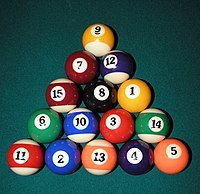Eight-ball
Eight-ball (also spelled 8-ball or eightball, and sometimes called solids and stripes, spots and stripes[1] or highs and lows) is a pool billiards played on a billiard table with six pockets, cue sticks, and sixteen billiard balls: a cue ball and fifteen object balls. The object balls include seven solid-colored balls numbered 1 through 7, seven striped balls numbered 9 through 15, and the black 8 ball. After the balls are scattered with a break shot, a player is assigned either the group of solid or striped balls once they have legally pocketed a ball from that group. The object of the game is to legally pocket the 8 ball in a "called" pocket, which can only be done after all of the balls from a player's assigned group have been cleared from the table.
The game is the most frequently played discipline of pool, and is often thought of as synonymous with "pool". The game has numerous variations, mostly regional. It is the second most played professional pool game, after nine-ball, and for the last several decades ahead of straight pool.[citation needed]
History[edit]
The game of eight-ball arose around 1900 in the United States as a development of pyramid pool, which allows any eight of the fifteen object balls to be pocketed to win. The game arose from two changes made, namely that the 8 ball must be pocketed last to win, and that each player may only pocket half of the other object balls. By 1925 the game was popular enough for the Brunswick-Balke-Collender Company to introduce purpose-made ball sets with seven red, seven yellow, one black ball, and the cue ball, which allowed spectators to more easily see which suit each ball belonged to. (Such colors became standard in the later British-originating variant, blackball). The rules, as officially codified in the Billiard Congress of America's rule book, were periodically revised in the years following.[2]:24, 89–90[3][4][5]
Standardized rules of play[edit]
American-style eight-ball rules are played around the world by professionals, and in many amateur leagues. Nevertheless, the rules for eight-ball may be the most inconsistent of any billiard game as there are several competing sets of "official" rules.
The non-profit World Pool-Billiard Association (WPA), which has continental and national affiliates around the world (some of which long pre-date the WPA, such as the Billiard Congress of America) promulgates standardized rules as Pool Billiards – The Rules of Play.[6] These are used for amateur and professional play.
Meanwhile, many amateur leagues – such as the American Poolplayers Association (APA) and its affiliate the Canadian Poolplayers Association (CPA), the Valley National Eight-ball Association (VNEA) and the BCA Pool League (BCAPL) – use their own rulesets which have slight differences from WPA rules and from each other. Millions of individuals play informally, using informal "house rules" which vary not only from area to area but even from venue to venue.
Equipment[edit]
The regulation size of the table's playing surface is 9 by 4.5 ft (2.7 by 1.4 m), though exact dimensions may vary slightly by manufacturer. Some leagues and tournaments using the World Standardized Rules may allow smaller sizes, down to 7 by 3.5 ft (2.1 by 1.1 m). Early 20th-century 10 by 5 ft (3.0 by 1.5 m) models are occasionally also still used. WPA professional competition generally employs regulation tables, while the amateur league championships of various leagues, including ACS, BCAPL, VNEA, and APA, use the seven-foot tables in order to fit more of them into the hosting venue.
There are seven solid-colored balls numbered 1 through 7, seven striped balls numbered 9 through 15, an 8 ball, and a cue ball. The balls are usually colored as follows:
- 1 and 9: yellow
- 2 and 10: blue
- 3 and 11: red
- 4 and 12: purple
- 5 and 13: orange
- 6 and 14: green
- 7 and 15: maroon
- 8: black
- Cue: white
Special sets designed to be more easily discernible on television substitute pink for the dark purple of the 4 and 12 and light tan for the darker maroon of the 7 and 15 balls, and these alternative-color sets are now also available to consumers.
Setup[edit]
To start the game, the object balls are placed in a triangular rack. The base of the rack is parallel to the

No comments:
Post a Comment